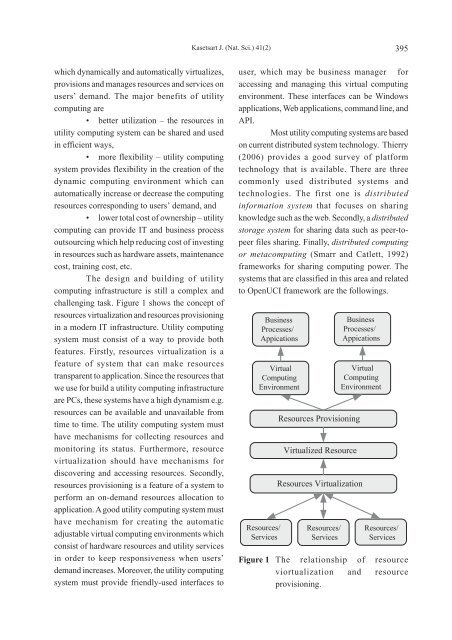April - June 2007 - Kasetsart University
April - June 2007 - Kasetsart University
April - June 2007 - Kasetsart University
Create successful ePaper yourself
Turn your PDF publications into a flip-book with our unique Google optimized e-Paper software.
which dynamically and automatically virtualizes,<br />
provisions and manages resources and services on<br />
users’ demand. The major benefits of utility<br />
computing are<br />
• better utilization – the resources in<br />
utility computing system can be shared and used<br />
in efficient ways,<br />
• more flexibility – utility computing<br />
system provides flexibility in the creation of the<br />
dynamic computing environment which can<br />
automatically increase or decrease the computing<br />
resources corresponding to users’ demand, and<br />
• lower total cost of ownership – utility<br />
computing can provide IT and business process<br />
outsourcing which help reducing cost of investing<br />
in resources such as hardware assets, maintenance<br />
cost, training cost, etc.<br />
The design and building of utility<br />
computing infrastructure is still a complex and<br />
challenging task. Figure 1 shows the concept of<br />
resources virtualization and resources provisioning<br />
in a modern IT infrastructure. Utility computing<br />
system must consist of a way to provide both<br />
features. Firstly, resources virtualization is a<br />
feature of system that can make resources<br />
transparent to application. Since the resources that<br />
we use for build a utility computing infrastructure<br />
are PCs, these systems have a high dynamism e.g.<br />
resources can be available and unavailable from<br />
time to time. The utility computing system must<br />
have mechanisms for collecting resources and<br />
monitoring its status. Furthermore, resource<br />
virtualization should have mechanisms for<br />
discovering and accessing resources. Secondly,<br />
resources provisioning is a feature of a system to<br />
perform an on-demand resources allocation to<br />
application. A good utility computing system must<br />
have mechanism for creating the automatic<br />
adjustable virtual computing environments which<br />
consist of hardware resources and utility services<br />
in order to keep responsiveness when users’<br />
demand increases. Moreover, the utility computing<br />
system must provide friendly-used interfaces to<br />
<strong>Kasetsart</strong> J. (Nat. Sci.) 41(2) 395<br />
user, which may be business manager for<br />
accessing and managing this virtual computing<br />
environment. These interfaces can be Windows<br />
applications, Web applications, command line, and<br />
API.<br />
Most utility computing systems are based<br />
on current distributed system technology. Thierry<br />
(2006) provides a good survey of platform<br />
technology that is available. There are three<br />
commonly used distributed systems and<br />
technologies. The first one is distributed<br />
information system that focuses on sharing<br />
knowledge such as the web. Secondly, a distributed<br />
storage system for sharing data such as peer-topeer<br />
files sharing. Finally, distributed computing<br />
or metacomputing (Smarr and Catlett, 1992)<br />
frameworks for sharing computing power. The<br />
systems that are classified in this area and related<br />
to OpenUCI framework are the followings.<br />
Business<br />
Processes/<br />
Appications<br />
Virtual<br />
Computing<br />
Environment<br />
Resources/<br />
Services<br />
Resources Provisioning<br />
Virtualized Resource<br />
Business<br />
Processes/<br />
Appications<br />
Virtual<br />
Computing<br />
Environment<br />
Resources Virtualization<br />
Resources/<br />
Services<br />
Resources/<br />
Services<br />
Figure 1 The relationship of resource<br />
viortualization and resource<br />
provisioning.
















